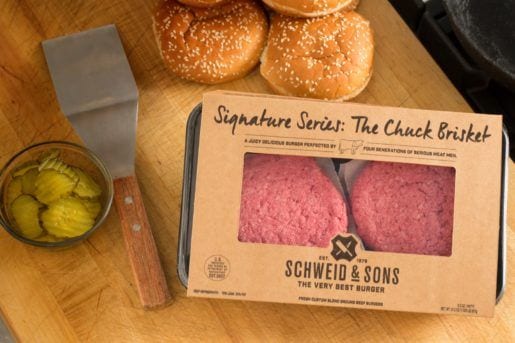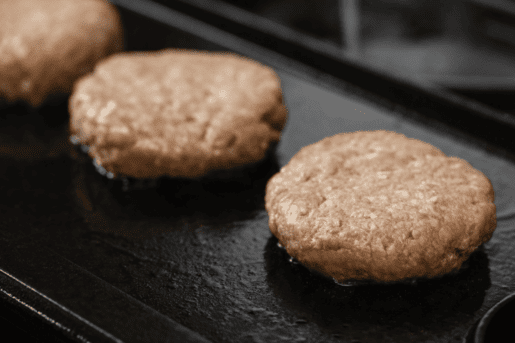Even if July wasn’t National Grilling Month, it would be hard to miss the fact that grilling reaches its peak at the height of summer. All across the Garden State, amateur al fresco chefs, armed with spatulas and hope, take to their backyards in pursuit of the perfect hamburger. It should be juicy, charred to perfection, and dressed better than Beyoncé on any given red carpet.
 But creating such a gastronomic gem is often easier said than grilled. Which meat is best? And what about cheese? But fear no more, would-be grillmasters. Here are some ideas to help take your patty game to the next level, courtesy of a real-life burger expert: Jamie Schweid, president of Schweid & Sons, the Carlstadt-based high-quality ground beef purveyor. They supply some of the most well-known names in hamburgers, including Five Guys and Bobby’s Burger Palace, as well as local faves The Ainsworth (Hoboken), Cloverleaf Tavern (Caldwell), Callahan’s (Fort Lee), The Chatterbox Drive-In (Augusta), Egan & Sons (Montclair), and Boardwalk Fries (Hoboken) … just to name a few.
But creating such a gastronomic gem is often easier said than grilled. Which meat is best? And what about cheese? But fear no more, would-be grillmasters. Here are some ideas to help take your patty game to the next level, courtesy of a real-life burger expert: Jamie Schweid, president of Schweid & Sons, the Carlstadt-based high-quality ground beef purveyor. They supply some of the most well-known names in hamburgers, including Five Guys and Bobby’s Burger Palace, as well as local faves The Ainsworth (Hoboken), Cloverleaf Tavern (Caldwell), Callahan’s (Fort Lee), The Chatterbox Drive-In (Augusta), Egan & Sons (Montclair), and Boardwalk Fries (Hoboken) … just to name a few.
If anybody has something to say about making the perfect burger, it’s the scion of this fourth-generation family-run company. Jamie and his brother Brad, who serves as executive vice president, literally grew up in the burger biz. Their great-grandfather, Harry Schweid, started a business selling meat to butchers and restaurants on New York City’s Lower East Side in the late 1800s. The company blossomed under the leadership of Harry’s son Sam, and later, Sam’s son David, the father of Jamie and Brad.
If it seems like gourmet burgers are suddenly having a moment — that’s because they are. “It’s become the steak of our generation,” Jamie Schweid said. “Don’t get me wrong, people still love a steak dinner. But it’s more of a celebratory event than a burger, which is a repetitive visit, which could be multiple times a week or month.”
But how do you get started on making that perfect burger?
Step 1: It’s All About that Beef
 The first step in creating the perfect burger is choosing the best blend of ground beef. The key to that process is understanding where the best flavor comes from. Basically, all meat — whether it’s beef, turkey or fish — consists of muscle fibers combined with connective tissue. The tenderness of any cut of meat depends on the ratio of connective tissue to muscle fiber. As a general rule of thumb, the more connective tissue there is, the less tender the cut is — and the amount of connective tissue increases with age and exercise. This is why veal is more tender than meat from older cows, and why sirloin is more tender than rump roast. So, what does this have to do with burgers?
The first step in creating the perfect burger is choosing the best blend of ground beef. The key to that process is understanding where the best flavor comes from. Basically, all meat — whether it’s beef, turkey or fish — consists of muscle fibers combined with connective tissue. The tenderness of any cut of meat depends on the ratio of connective tissue to muscle fiber. As a general rule of thumb, the more connective tissue there is, the less tender the cut is — and the amount of connective tissue increases with age and exercise. This is why veal is more tender than meat from older cows, and why sirloin is more tender than rump roast. So, what does this have to do with burgers?
“I think there’s two ideal great blends for the consumer,” Schweid said. “One is a percentage of chuck and a percentage of brisket. In a burger it’s a great mixture. Chuck gives [the burger] a firm texture because it comes from the front of the animal…It’s a worked muscle, and so it’s a really great grinding base for a burger. And then you have brisket, which is a little more flavorful, and also a little looser in its texture so combining the two makes for an absolutely delicious hamburger. The other blend that we love is a USDA Prime chuck, so it gives it a very clean taste and a really, really good texture.”
That clean taste, Schweid explains, is the result of certain fatty acids that are naturally present in brisket, and less so in chuck. The fatty acid, which is called oleic acid, contributes to a rich, hearty flavor.
Step 2: Consider Buying Pre-Made Patties
 “I would argue that you want to buy [patties] store-bought instead of making by hand because when making a burger by hand, you start overworking [and] adding heat to that meat,” Schweid, whose burgers are available in supermarkets such as Kings Food Market, Shop Rite and Foodtown — said. “You’re adding that heat from your hand, so what it ends up doing is it makes the meat a little more bland. So if you’re going to have big patties, you really want to buy it preformed already so you’re not overworking it.”
“I would argue that you want to buy [patties] store-bought instead of making by hand because when making a burger by hand, you start overworking [and] adding heat to that meat,” Schweid, whose burgers are available in supermarkets such as Kings Food Market, Shop Rite and Foodtown — said. “You’re adding that heat from your hand, so what it ends up doing is it makes the meat a little more bland. So if you’re going to have big patties, you really want to buy it preformed already so you’re not overworking it.”
Step 3: Don’t Trim the Fat
 Despite what many of us have read in health and fitness news, super lean meat does not a perfect burger make. The same fatty acids that contribute richness and flavor to a burger also help it maintain moisture during the cooking process. Therefore, some fat is necessary to achieve the juiciest, tastiest burger possible. Schweid recommends checking the fat-to-lean ratio of the ground beef patties before you buy.
Despite what many of us have read in health and fitness news, super lean meat does not a perfect burger make. The same fatty acids that contribute richness and flavor to a burger also help it maintain moisture during the cooking process. Therefore, some fat is necessary to achieve the juiciest, tastiest burger possible. Schweid recommends checking the fat-to-lean ratio of the ground beef patties before you buy.
“It’s so important when shopping for beef, especially ground beef, to check the fat-to-lean ratio,” he said. “If you go in and you look in the retail stores today, [there are a lot of] 90/10s or 95/5s, which is 90-percent lean, 10-percent fat, or 95-percent meat, 5-percent fat. The [meat is] really, really red in nature, and what happens is they’re going to cook very quickly but there’s no flavor. Fat equals flavor.
“It might be a little healthier than what you get with what we make, which is 80/20 and a 75/25, but the…overwhelming flavor of our burgers are incredible. Because our burgers are anywhere between 75-percent lean/25-percent fat and 80-percent lean/20-percent fat, you get a very flavorful, tasty burger with a lot of juice flowing through it. As opposed to a burger that’s 95/5 or 90/10 that’s really, really lean, but that’s very dry.”
So keep your burger flavorful and fatty — and jog home from the BBQ.
Step 4: Use a Flat Top for Better Heat Distribution
 As individual as DNA, personal grilling preferences vary widely and everyone has an opinion.
As individual as DNA, personal grilling preferences vary widely and everyone has an opinion.
“Everyone has their own methodology with the grill,” Schweid said. “I don’t like the smoky flavor that you get when you put the burger on a charcoal grill. I actually bought a flat top [to] put over the grill.”
“It’s a very different texture of a burger when you’re cooking it on a char grill versus cooking on a flat top,” he continued. “That [heat] distribution is probably more consistent on a flat top than it is on a char [grill] just because of where the flames are. But it really is the charcoal, right? When you put the hood over it and you’re getting that smoke, and you’re almost … almost putting a cover over the burger as you’re cooking it. Whereas on a flat top that’s not the case, so it’s more of an open cooking environment. And you’re also cooking the burger in its own juice [as opposed to on] a char grill, [where] all that juice comes out of the burger and ignites the flame.”
Step 5: Melt the Cheese Properly, and Serve Hot
 For Schweid, the perfect burger is naked without properly melted cheese.
For Schweid, the perfect burger is naked without properly melted cheese.
“You know, when you go to a barbecue, and your buddy’s on the grill, and they say ‘Who wants cheese?'” he said. “And they just throw cheese on it, and about five seconds later they take the burger off the grill and they serve it to you, and you’re sitting with a cold piece of cheese on the burger? That’s definitely not ideal. You’ve got to make sure that the cheese is melted beautifully and covering or encompassing the whole burger.”
Timing is everything when it comes to making the perfect cheeseburger. As far as doneness goes, Schweid recommends what he calls the “face method” to tell when your burger is just right. Tap the burger and compare it to your face: “Your cheek is rare, your chin is medium rare, your nose is medium and your forehead is well done.”
And perhaps most importantly, remember to serve your burger immediately. “It really only stays hot for three to four minutes depending on how it’s stacked,” Schweid said. “You can’t make a burger and twenty minutes later serve it, it just doesn’t work.”
So what’s the expert’s favorite burger? Schweid likes his meat served medium rare and piping hot with a sweet, tomato-based barbecue sauce. “I’m a huge fan of barbecue sauce. I feel it’s a really underrated condiment. I like the sweetness of it,” he said, adding, “the popular steak sauces are sweeter, like at Peter Luger’s.”
Just don’t add mayo or mustard to your masterpiece. According to Schweid. “[They] don’t belong on hamburgers.”
Hero (Top) Feature Image: ©George Motz
Additional Images (in Order) Courtesy:
George Motz
Wikimedia/Ysangkok
Schweid & Sons
All other images courtesy George Motz












